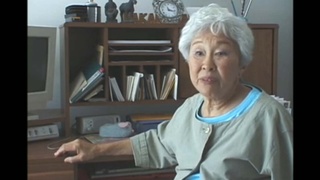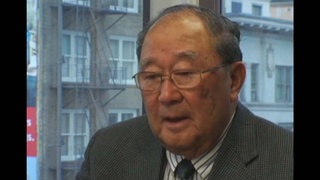Interviews
Suffering in World War II (Spanish)
(Spanish) So much suffering, so much bad blood, hunger, everything bad that could be found in humanity [took place then]. I believe that it was very positive, [however]; the knowledge of that suffering [can be shared with] the youth [of today] who do not have [such] problems [and they can learn from the past]. In order to eat we had problems at that time in Nihon (Japan). The rationing of rice was common. In place of rice, they gave you biscuits (bizcocho, bizcochuelo), or more or less they gave you poroto…or also they could give you sweet potatoes instead of [regular] potatoes. With that you had to maintain yourself; you did not have salt, no sugar. Do you know how we salted foods, to make foods salty? We went to the beach in search of sea water…in nihongo one says oke, which is a wooden pot that we carried on our shoulders and brought salt water in order to obtain salt. Forget about sugar during that time. Every person who lived during that time is better off because they know what suffering is all about. And most are my age or even older, and there are many who have died. Thus, from that time period it was so variable, so variable, but also, I say, from one province to the next, there was much variation […] there were cities that were not bombed out, [although] the majority were bombed […] the provinces that were not bombed out…were very lucky.
Date: September 18, 2006
Location: Buenos Aires, Argentina
Interviewer: Takeshi Nishimura, Ricardo Hokama
Contributed by: Centro Nikkei Argentino
Explore More Videos

Importance of education in achieving redress for incarceration
(1919-2014) Activist for civil rights and redress for World War II incarceration of Japanese Americans.

New Year's food
(b.1964) California-born business woman in Japan. A successor of her late grandmother, who started a beauty business in Japan.

Her experience as a Japanese-American schoolchild in Oceanside, California, after the bombing of Pearl Harbor
(1924-2018) Artist and playwright.

Food growing up
(b.1948) Nikkei from Southern California living in Japan.

Learning American cooking
(b.1909) Nisei from Washington. Incarcerated at Tule Lake and Minidoka during WWII. Resettled in Chicago after WWII

Loss of happy-go-lucky adolescence in Puyallup Assembly Center
(b. 1923) Nisei from Washington. Resisted draft during WWII.

Memories of dusty conditions at Minidoka incarceration camp
(b. 1923) Nisei from Washington. Resisted draft during WWII.

Making the decision to resist the draft
(b. 1923) Nisei from Washington. Resisted draft during WWII.

Discharged from the U.S. Army after Pearl Harbor
(b. 1918) Founder Azumano Travel

Reaction to a 1942 speech by Mike Masaoka, Japanese American Citizen League's National Secretary
(1915 - 2011) Nisei florist who resettled in New York City after WW II. Active in Japanese American civil rights movement

Death of sister in October 1942
(1915 - 2011) Nisei florist who resettled in New York City after WW II. Active in Japanese American civil rights movement

First impression of New York City during war time
(1915 - 2011) Nisei florist who resettled in New York City after WW II. Active in Japanese American civil rights movement

Neighbors' sympathy after Pearl Harbor
(1915 - 2011) Nisei florist who resettled in New York City after WW II. Active in Japanese American civil rights movement

Little contact with Asians growing up on the east coast
Japanese American Creative designer living in Japan

Reaction of Japanese American community toward draft resistance stance
(b. 1925) Draft resister
